[0010] To address the above discussed design constraints and the needs of the plastic manufacturing and entertainment industries, the invention provides an efficient and economical method to produce plastic objects, such as containers, with Lenticular material included as an integral insert. This method produces a unique
plastic object with the features of 3D
graphics and / or animated video clips showing a fraction of a second to up to several seconds when viewing the Lenticular insert from the outer surface of the
plastic object. The object resulting from the process is a durable, one
piece unit with outstanding
graphics such as animated video clips showing up to 3 to 5 seconds of live or computer generated graphics or the latest 3D technology. The Lenticular insert that provides these unique visual imagery comprises generally Lenticular material having optical ridges and grooves on an outer surface and a layer or transparent web of lenses, which together create a relatively rigid material with air passages or voids. A layer of ink is attached to the flat side of the transparent lens layer. The actual images are pre-printed in this ink layer on the back side or second surface of the pre-extruded or post-embossed plastic lens material which may be made of a variety of
plastic materials including, but not limited to, APET, flexible or rigid PVC,
styrene, and PETG. The actual images are interlaced corresponding to the frequency of the
Lenticular lens material (i.e., the optical ridges and grooves and the transparent lens layer) and are then printed using offset
lithography, web, letterpress, digital, screen, or any other printing process. One method of printing to achieve high quality is
offset printing with UV cured links.
[0011] According to one aspect of the invention, a
plastic object is produced that provides several beneficial features or characteristics desired by the plastic manufacturing industry. For example, in one preferred embodiment, a container, such as a stadium-type cup, is provided with an outer wall that includes a Lenticular insert. Preferably, the Lenticular insert is an integral part of the outer wall and extends around the periphery of the wall to cover a significant portion of the outer wall surface area. Due to the
air voids, the Lenticular insert acts as a thermal barrier or an
insulation layer that reduces
heat transfer rates through the outer wall and makes the container more useful for hot and cold service. Additionally, the optical ridges of the Lenticular insert cause the insert to function as an attached gripping surface by increasing the roughness of the outer wall (which in standard plastic containers is smooth). Because of the strength and rigidness of the Lenticular insert, the outer wall of the container has high strength and specifically, has improved hoop strength. Additionally, the strength and rigidness of the Lenticular insert allows material in the outer wall to be eliminated, thereby reducing the amount of raw plastic needed for forming the container. In the traditional cup business, the major manufacturers are continuously trying to remove weight from the product to reduce material costs and to make the molds cycle faster (e.g., weight reduction is one way to speed the cycle). Additionally, as will become clear from the discussion of the fabrication method of the invention, inserting the Lenticular insert into the mold prior to injecting the molten plastic material allows the Lenticular insert to act as a carrier and a stiffener for the
molten material. This allows the manufacturer to open the mold faster to reduce cycle times and allows the wall thickness of the container to be reduced giving a reduced part weight. A prototype of a standard-sized, stadium cup fabricated by the inventors had approximately 53 grams in molded plastic content which is an improvement over the prior art and it is expected that a plastic content of about 30 grams or less will provide acceptable strength and durability. In other words, a container including the Lenticular insert provides desirable strength characteristics with reduced container manufacturing times and molding-plastic material costs.
[0012] According to a related aspect of the invention, the container in a preferred embodiment includes a framing
system to physically hold the Lenticular insert against or within the outer wall of the container. As noted previously, the ink layer does not provide an effective bonding surface for bonding with molten plastic in container fabrication processes (but, as will become clear, in a preferred embodiment of the invention a protective substrate or laminate is applied to the ink layer to provide a bonding surface). The framing
system provides one method of overcoming this problem by including upper, lower, and seam frame members that slightly overlap each of the edges of the Lenticular insert (more frame members can be included if the Lenticular insert has more than four sides). Preferably, the seam frame member fills a small gap left between the Lenticular insert side edges and overlaps both side edges. This configuration of the seam member is preferred to improve the strength of the container because
cracking may occur if the side edges were merely butted against each other. The frame members further function to protect exposed surfaces of the Lenticular insert from
scratching and other damage during handling and storage (such as stacking or nesting of containers or cups) by providing a slightly raised surface adjacent the exposed surface. The frame members are bonded to the outer wall of the container, and in this regard, a preferred method of forming the frame members is to configure the mold cavity for creating the frame members during the molding process which makes the frame members integral with the outer wall of the container.
[0013] According to another aspect of the invention, a fabrication method is provided that forms a plastic object, such as a container, with an integral Lenticular insert that includes processes for protecting the ink of the Lenticular insert. Typical plastic fabrication processes, such as injection molding and
blow molding, involve the heating of the raw plastic or charge material to high temperatures to make the plastic fluid or moldable but without further processes, these high temperatures would also degrade or ruin the ink. In this regard, the fabrication method of the invention includes the step of applying and / or bonding a protective substrate to and over the ink layer of the Lenticular insert prior to inserting the Lenticular insert into the mold cavity for
plastic molding of the plastic object. The substrate may be formed using numerous materials such as
coating materials and many plastics. The substrate is preferably bonded to the ink in a manner that does not degrade the ink but yet achieves a bond that will withstand the temperatures and pressures experienced in the molding processes and, in some applications, in the later use of the container. Although adhesives may be used, one preferred embodiment involves a
two step process in which a plastic hot melt or laminate is first applied to a carrier or liner sheet and then when cooled, the plastic, hot melt / laminate is activated by heat and pressure applied to achieve a bond to the ink layer. In this fashion, a much lower temperature (i.e., a temperature that does not degrade the ink layer) can be used to bond the laminate to the ink, as the laminate is not molten. The carrier is preferably a quick
release liner that can be readily removed from the attached laminate and the laminate is exposed. The laminate acts as a thermally protective layer or substrate in later
plastic molding processes such that the ink is not destroyed and a plastic object with a Lenticular insert can be readily formed using standard plastic
processing techniques.
 Login to View More
Login to View More 


